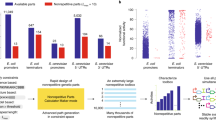Abstract
This short paper introduces a new way by which to design production system rules. An indirect encoding scheme is presented which views such rules as protein complexes produced by the temporal behaviour of an artificial genetic regulatory network. This initial study begins by using a simple Boolean regulatory network to produce traditional ternary-encoded rules before moving to a fuzzy variant to produce real-valued rules. Competitive performance is shown with related genetic regulatory networks and rule-based systems on benchmark problems.








Similar content being viewed by others
References
Bacardit J, Garrell J (2003) Evolving multiple discretizations with Adaptive intervals for a pittsburgh reul-based learning classifier system. In: Cantu-Paz E et al. (eds) Proceedings of the 2003 genetic and evolutionary computing conference. Springer, pp 1818–1831
Bray D (1995) Protein molecules as computational elements in living cells. Nature 376:307–312
Bentley P (2004) Adaptive fractal gene regulatory networks for robot control. In: Workshop proceedings of the genetic and evolutionary computation conference. Gecco (CD)
Bull L (2009) On dynamical genetic programming: simple Boolean Networks in learning classifier systems. Int J Parallel Emergent Distrib Syst 24(5):421–442
Bull L (2012a) Using genetical and cultural search to design unorganised machines. Evolut Intell (in press)
Bull L (2012b) Evolving Boolean Networks on tunable fitness landscapes. IEEE Trans Evolut Comput (in press)
Bull L (2012c) A simple computational cell: coupling Boolean gene and protein networks. Artif Life (in press)
Bull L (2012d) On natural genetic engineering: structural dynamism in random Boolean Networks. Arxiv: http://arxiv.org/abs/1201.3545
Derrida B, Pomeau Y (1986) Random networks of automata: a simple annealed approximation. Europhys Lett 1:45–49
Fisher M, Paton R, Matsuno K (1999) Intracellular signaling proteins as ‘smart’ agents in parallel distributed processes. BioSystems 50:159–171
Floreano D, Dürr P, Mattiussi C (2008) Neuroevolution: from architectures to learning. Evol Intel 1(1):47–62
Fretter C, Szejka A, Drossel B (2009) Perturbation propagation in random and evolved Boolean networks. New J Phys 11(3): 033005
Holland JH (1975) Adaptation in natural and artificial systems. University of Michigan Press, Ann Arbor
Holland JH (1976) Adaptation. In: Rosen R, Snell FM (eds) Progress in theoretical biology 4. Plenum, New York, pp 263–293
Kauffman SA (1969) Metabolic stability and epigenesis in randomly constructed genetic nets. J Theor Biol 22:437–467
Kauffman SA (1993) The origins of order. Oxford University Press, Oxford
Kennedy J, Eberhart R (1995) Particle swarm optimization. In: Proceedings of IEEE international conference on neural networks. IEEE Press, pp 1942–1948
Knibbe C, Fayard J-M, Beslon G (2008) The topology of the protein network influences the dynamics of gene order: from systems biology to a systemic understanding of evolution. Artif Life 14:149–156
Kok T, Wang P (2006) A study of 3-gene regulation networks using NK-Boolean network model and fuzzy logic networking. In: Fuzzy applications in industrial engineering. Studies in fuzziness and soft computing, vol 201. Springer, Berlin, pp 119–151
Lemke N, Mombach J, Bodmann B (2001) A numerical investigation of adaptation in populations of random Boolean Networks. Phys A 301:589–600
Paton R (1993) Some computational models at the cellular level. BioSystems 29:63–75
Preen R, Bull L (2009) Discrete dynamical genetic programming in XCS. In: Proceedings of the 2009 genetic and evolutionary computation conference. ACM Press, pp 1299–1306
Preen R, Bull L (2011) Fuzzy dynamical genetic programming in XCSF. In: Proceedings of the 2011 genetic and evolutionary computation conference. ACM Press, pp 167–168
Qadir O, Liu J, Timmis J, Tempesti G, Tyrrell AM (2010) Principles of protein processing for a self-organising associative memory. In: Proceedings of the 12th IEEE congress on evolutionary computation. IEEE Press
Sipper M, Ruppin E (1997) Co-evolving architectures for cellular machines. Physica D 99:428–441
Smith SF (1980) A learning system based on genetic adaptive algorithms. PhD Thesis, University of Pittsburgh
Stone C, Bull L (2003) For Real! XCS with continuous-valued inputs. Evol Comput 11(3):299–336
Storn R, Price K (1997) Differential evolution: a simple and efficient heuristic for global optimization over continuous spaces. J Glob Optim 11:341–359
Tan P, Tay J (2006) Evolving Boolean Networks to find intervention points in dengue pathogenesis. In: Keijzer M et al. (eds) Proceedings of the 2006 genetic and evolutionary computation conference. ACM Press, pp307–308
Van den Broeck C, Kawai R (1990) Learning in feedforward Boolean Networks. Phys Rev A 42:6210–6218
Wilson S (2000) Get real! XCS with continuous-valued inputs. In: Lanzi P-L et al. (eds) Learning classifier systems: from foundations to applications. Springer, Berlin, pp 209–222
Yao X (1999) Evolving artificial neural networks. Proc IEEE 87(9):1423–1447
Author information
Authors and Affiliations
Corresponding author
Rights and permissions
About this article
Cite this article
Bull, L. Production system rules as protein complexes from genetic regulatory networks: an initial study. Evol. Intel. 5, 59–67 (2012). https://doi.org/10.1007/s12065-012-0078-3
Received:
Accepted:
Published:
Issue Date:
DOI: https://doi.org/10.1007/s12065-012-0078-3




